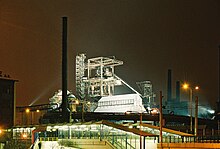Upper Silesian metropolitan area
Upper Silesian metropolitan area
obszar metropolitalny konurbacji górnośląskiej Slezská Metropolitní oblast | |
|---|---|
 | |
| Country | Poland, Czechia |
| Region | Mainly Silesia |
| Largest Cities | Katowice Ostrava Sosnowiec Gliwice Zabrze Bytom |
| Area | |
| • Metro | 5,400 km2 (2,100 sq mi) |
| Population | |
| • Metro | 5,294,000 |
| • Metro density | 980/km2 (2,500/sq mi) |
| Time zone | UTC+1 (CET) |

The Upper Silesian metropolitan area is a metropolitan area in southern Poland and northeast Czechia, centered on the cities of Katowice and Ostrava in Silesia and has around 5 million inhabitans. Located in the three administrative units (NUTS-2 class): mainly Silesian Voivodeship, a small western part of Lesser Poland Voivodeship and a small east part of Moravian-Silesian Region.
The lies within the Upper Silesian Coal Basin. Silesian metropolitan area (5.3 million people) with nearby Kraków metropolitan area (1.3 million[1][2][3][4][5] people) and Częstochowa metropolitan area (0.4 million[1][2][3] people) create a great metropolitan area covering 7 million people.
Statistics[]
Upper Silesian metropolitan area has a population of 5,294,000, with 4,311,000 (81.43%) in Poland (the Upper Silesian polycentric metropolitan area) and 983,000 (18.57%) in Czechia (Ostrava Functional Urban Area).[1] According to Polish Scientific Publishers (PWN) area is 5,400 km², with 4,500 km² (83.33%) in Poland and 900 km² (16.67%) in Czechia.[6] According to the Brookings Institution, area has a population of 5,008,000.[7]
The area consists of several Functional Urban Areas (FUA), each of which is defined as a core Morphological Urban Area (MUA) based on population density plus the surrounding labour pool, i.e. a metropolitan area. This area contains the following FUAs:[1]
- Katowice FUA: 3,029,000 (see also Katowice urban area); within Upper Silesian Industrial Region
- Bielsko-Biała FUA and Cieszyn FUA: 647,000 (584,000 + 63,000); within north of Cieszyn Silesia and Bielsko Industrial Region
- Rybnik FUA, Wodzisław Śląski and Racibórz FUA: 634,000 (526,000 + 109,000); within Rybnik Coal Area
- Ostrava FUA: 983,000; within
Data may vary depending on the source, example for same the Katowice city exist sources for 3.5 million people;[8][9] for the Rybnik – 507,000,[3] while for the Ostrava – 1,153,876.[2]
Economy[]
Historically, most of the area was characterized by heavy industry since the age of industrialisation in the late 19th and early 20th century. In addition to coal, Upper Silesia also contains a number of other minable resources (methane, cadmium, lead, silver and zinc). Resources of coal to a depth to 1000 meters – about 70 billion tons, the conditions for the extraction – good.[6]
See also[]
- Rhine-Ruhr
- Katowice urban area, part of the Upper Silesian metropolitan area
- Upper Silesian Industrial Region
- Silesian Metropolis, a political and economic association of local municipalities
 Lower Vítkovice in Ostrava, former mining complex, today national site of industrial heritage including .
Lower Vítkovice in Ostrava, former mining complex, today national site of industrial heritage including .
References[]
- ^ a b c d (in English) European Spatial Planning Observation Network (ESPON) "ESPON project 1.4.3. Study on Urban Functions" Archived 2015-09-24 at the Wayback Machine – Final report, March 2007, ISBN 2-9600467-2-2
- ^ a b c (in English) Eurostat, Urban Audit database Archived 2011-04-06 at the Wayback Machine, accessed on 2009-03-12. Data for 2004.
- ^ a b c (in Polish) "Społeczne i polityczne zróżnicowanie aglomeracji w Polsce" – Paweł Swianiewicz, Urszula Klimska Archived 2009-01-24 at the Wayback Machine; University of Warsaw 2005
- ^ (in Polish) Funkcje Metropolitalne Pięciu Stolic Województw Wschodnich Archived 2009-03-27 at the Wayback Machine – Tadeusz Markowski
- ^ (in Polish) "Koncepcja przestrzennego zagospodarowania kraju" Archived 2010-03-31 at the Wayback Machine – Ministry of Regional Development, 2003
- ^ a b (in Polish) "Górnośląskie Zagłębie Węglowe" – PWN Encyclopedia
- ^ "Redefining Global Cities". Brookings Institution.
- ^ (in English) www.worldatlas.com
- ^ (in Polish) "Górnośląski Okręg Przemysłowy" – PWN Encyclopedia
- Metropolitan areas of Poland
- Geography of Silesian Voivodeship
- Moravian-Silesian Region
- Transborder agglomerations

